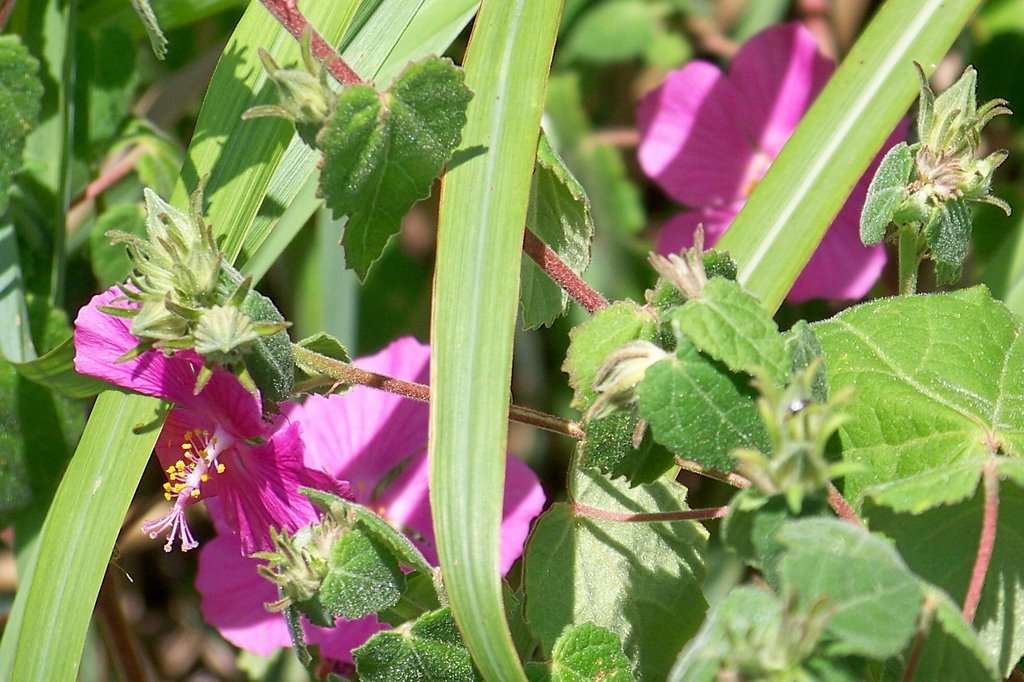

Long before I started to become aware of the names of plants and before I ever started growing them myself, I dreamed about the Texas madrone, Arbutus xalapensis var. texana (Pictures above are from Big Bend National Park.) This striking tree can be found in the Texas Hill County and in the hills and mountains of West Texas. It’s related to the strawberry tree, Arbutus unedo of Europe, and the Pacific madrone, Arbutus menziesii. Texas madrone has been called naked Indian or lady’s legs because its reddish bark peels back showing a pinkish to whitish inner bark depending on where you see the tree. The peeling bark of the madrone is perhaps one of the most beautiful displays in nature. Its light wood is extremely strong, which might explain why it used to be harvested for tool handles and for saddles. The berries are red, and they are edible. I haven’t tried them, so I can’t tell you how good they are. I’ll do that one of these days if I can beat the birds to one. Years after I had seen my first madrone, I had no problem identifying in a plant book what took over my imagination. The leaves are tropical in appearance, and the creamy white flowers look like tiny bells, which illustrate its membership in the blueberry or heath family of plants. It can grow in some tough places, often poking right of rocky locations, but usually can be found near its nursery plant, the juniper, Juniperus ashei. While the Texas madrone is notoriously tough, nurserymen have a hard time selling them because of their high transplant failure rate. I’ve tried to grow a few of them. No matter what strategy I took, the plant just ups and dies on me. They are obviously sensitive to the level of moisture in the soil, and some speculate that there is a special mycorrhizal fungus in the soil that forms a symbiotic relationship with the tree’s roots to supply it with a necessary amount of nutrients. Natives of Texas near Medina sells madrones, and they tell you to cut the pot away from the plant so you don’t disturb the root ball. They also tell you to put some juniper mulch to increase its chance of survival. The hope is to inoculate the plant with that special mycorrhizal fungus and to provide it with some nutrients it prefers. I’ve been a highly successful gardener, but I’ve yet to elevate myself to the challenge of a madrone. I will try again, and I’m plotting some new strategies. I want to build an elevated bed with juniper mulch on top of a limestone undersoil. I just have to convince my wife to let me fork out the big bucks for another madrone seedling. We’ll see. In the meantime, I’m dreaming of going back to West Texas to see the madrones growing amongst the junipers, the big tooth maples (Acer grandidentatum), agave havardiana, sotol (Dasylierion leiophyllum), Thompson yucca (Yucca thompsoniana) and many others.


5 comments:
Minnette and I several months ago saw some madrones in southwest Austin that had maroon leaves! I don't know if the leaf color was seasonal or if these were always that way. It was in a small area with several beautiful old trees plus seedlings, but only two of the trees had the maroon foliage.
And on the Ashe Juniper as a nurse plant and a soil builder, Del Weniger once wrote that the mass clearing of Ashe Junipers that's ongoing in central Texas may result in impoverished soils.
Wow, now that's a sight I'd like to see. I've seen some madrones southwest of Austin near San Marcos growing along the side of the road. I've been told of some madrones growing in Leander. I was at the nursery of a native plant hunter, and his friend came in tell of this huge madrone right in the middle of an undeveloped plot of land in a residential subdivision. That madrone probably was killed because there would be no way to put a house on the property and keep the tree. Sigh.
Who knows where to download XRumer 5.0 Palladium?
Help, please. All recommend this program to effectively advertise on the Internet, this is the best program!
I have madrones growing on my place in Startzville, south side of Canyon Lake. I've noticed leaves going temporarily maroon when temps freeze for more than 24 hours.
I've been fascinated with the trees. I read tonight that the berries are edible, and I will definitely beat the birds to some.
I've wanted to take out some of the Ashe juniper here, and will be sure to leave any that shelter madrones. I also use cut juniper to lay informal terraces, to slow erosion and build up soil. I've noticed that madrones like to start in these piles, as long as they stay undisturbed and protected in the piles for several years.
Post a Comment